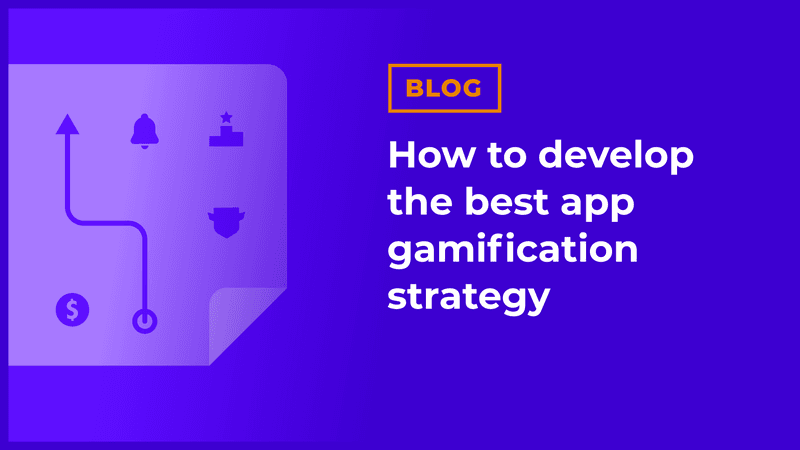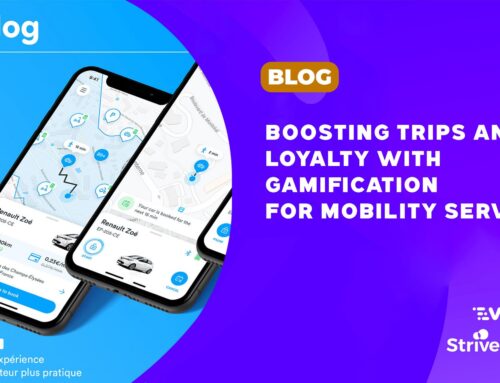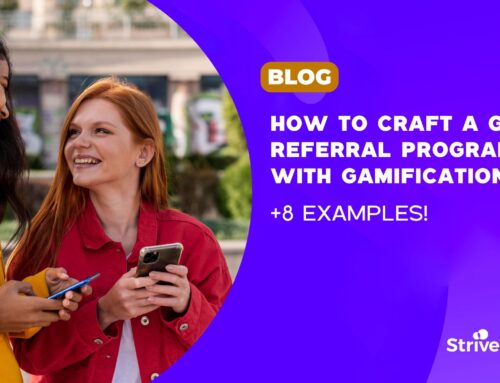How to develop the best app gamification strategy – everything you need to know!

Just like you wouldn’t expect to fit a square peg in a round hole, a gamification strategy is not one-size-fits-all. In fact, what makes gamification so powerful is because it is personalized! Given that, the shape of your gamification strategy depends on what you are trying to achieve. From mobile app engagement to user retention, you will need to decide what your goals are and which gamification features will get you there.
In this article, we’ll cover how to develop your own gamification strategy, as well as briefly touch on some gamification examples from apps that have successfully pulled it of.
- What is an app gamification strategy?
- Why gamification is an effective strategy for mobile app engagement
- 5 gamification examples you need to know
- How app gamification strategies vary by app category
- How StriveCloud can help you find the right gamification strategy
- Recap
What is an app gamification strategy?
Gamification is the use of game-like elements in non-game contexts. To go into more detail, gamification leverages the data mined from user behavior to incentivize user actions that align with your business goals. Essentially, it’s a means of persuasion!
But what makes it so persuading? Gamification taps into the deepest parts of our psychology and makes using an app fun and rewarding. It does this by exploiting both intrinsic and extrinsic motivation. To clarify, intrinsic motivation means that the app is naturally satisfying to use. On the other hand, extrinsic motivation is persuasion by means of tangible rewards, such as prizes or visual progress.
Of course, gamification features vary depending on what you are offering your users, who those users are, and what you are trying to persuade them to do. For example, a fitness app and a banking app will require totally different solutions! Equally, certain gamified elements affect a 20-year-old differently than a 50-year-old.
With that in mind, you will need to develop your own app gamification strategy. This requires a few considerations:
- What is your goal? Is it retention, activation, or mobile app engagement?
- Who is your audience? Research shows that young people react more positively to intrinsic motivation than older people, who tend to prefer extrinsic motivators.
- What is your data? Simply put, what are you gathering from your users? This changes what you can leverage. Without data, you have nothing to gamify!
Why gamification is an effective strategy for mobile app engagement
Engaged users will bring your business many benefits. An analysis by Gallup found that genuinely engaged customers are more loyal to your brand, and more profitable than the average customer by a 23% margin!
In concrete terms, here are a few places where that 23% rise comes from:
A boost in organic installs. A genuinely fun app to use will prompt users to recommend the app to their friends and family. Studies find that gamification can increase referral traffic by as much as 250%!
An enjoyable onboarding process reduces user churn. Across all apps, Day 1 user retention never rises above 33%. That means 2/3 of those who install your app will have already dropped it within 24 hours! To combat this, a gamified and user-friendly onboarding process makes the process enjoyable. Case studies show that a gamified onboarding experience can affect engagement and retention with a 50% increase.
Higher levels of mobile app engagement result in more efficient marketing. For instance, if you know more about your audience because they use your app more, a push notification promoting an offer is more likely to find the right audience! This effect is like a positive feedback loop, as it needs the initial boost to work its magic. Case studies show that the engagement gained through gamification results in a productivity boost in R&D and digital marketing.
5 gamification examples you need to know
You will certainly recognize some of the most popular gamification examples, which have wide-ranging applications and are excellent at creating customer motivation:
#1 Progress bars

The profile set-up progress bar on LinkedIn boosted profile completion by 55%!
Progress bars are so simple but so powerful. Its have been found to reduce the ‘cognitive load’ of a loading screen or during onboarding. In other words, it makes things easier for the user by providing information in steps, and rewarding users throughout completing them. The process requires less effort on the user’s part, resulting in higher levels of completion.
#2 User rewards

The Starbucks user rewards program is responsible for an incredible 40% of all US sales.
Rewarding your users is one of the best ways to make your app ‘sticky’ and keep customers coming back for more. This is the key to creating loyal customers who not only recommend your brand to others but spend almost 3x as much as the average user.
#3 Leaderboards

A study found that the Fitbit leaderboard led to a 15% increase in daily steps.
A leaderboard motivates both yourself and your peers! By introducing an element of social interaction into user activity, your app will feel far more real. Research confirms that feeling part of a larger community leads to long-term mobile app engagement.
#4 Badges

The Duolingo badge system boosted user referrals by 116%!
Badges are an easy way of giving your users instant feedback. Immediately, users will feel like their tasks have meaning. In addition, the rush of receiving a badge will push them to achieve the next one. The science shows that it works – studies into the gamification of the Nike Run Club showed that badges ‘sustain engagement’.
#5 Challenges

In just two weeks in 2018, Adidas Running raised $1 million with their Run for the Oceans challenge.
Challenges give users a clear purpose within your app. It’s a great way to get users started. Think about all the “30 days of…” programs! Research by Mckinsey shows that challenges create a flow-like state where people are more productive and motivated. The logic behind it is that people are more motivated to work and progress towards a goal, rather than completing separate grunt tasks without a purpose.
Bonus tip: Group challenges fulfill your users’ need for competition and community by giving them an opportunity to flex their muscles! People love to show off their efforts or work together to achieve a common goal.
How app gamification strategies vary by app category
Whatever your app does, these gamification examples can be adapted to your niche!
Gamification in fitness apps
Did you know that over half of all fitness apps contain at least 1 element of gamification? For sure, gamification continues to be an important consumer trend in fitness. Creative gamification examples include SWEAT’s before-and-after photo function, which encourages users to share a side-by-side photo of themselves before a workout course, and one following it, to show off their progress!
CEO Kayla Itsines credits this as the biggest reason her app became the #1 most profitable fitness app in the world.

Gamification in banking apps or fintech
Digital banks are thriving! Gamification has been instrumental in creating the mobile app engagement that has made Revolut the biggest fintech app in Europe. Their leaderboard is combined with a prize pool, where the leaders get a chance of winning a piece of the £250,000 grand total. To gain points, users have to make transactions and refer friends!

Gamification in learning apps
Believe it or not, but a virtual alien can help encourage you to learn a language. Memrise, for instance, starts off your course with a little story. To begin, you are an astronaut with a pet alien, trying to learn a new language. As you study, your alien grows up! It is an inventive way to reward users for completing courses and creates a fun and visually clear way to track your progress. Gamification examples like these are instrumental in habit formation, which is essential in order for educational apps to maintain customer motivation.

How StriveCloud can help you find the right gamification strategy
Tired of users churning? Does it feel like nothing you do actually keeps users engaged for longer? Do you want to follow in the footsteps of these successful apps, without feeling like a copycat?
If you want to gamify your user experience, but have no idea where to start we have the solution for you!
Every app requires a different gamification strategy. StriveCloud specializes in gamification for apps to lift up customer motivation and increase mobile app engagement and retention. We have worked with clients across banking, mhealth, mobility, and many more industries!
In StriveCloud’s custom gamification workshops we focus on developing your own gamification strategy, tailored to your app, audience, and business goals. Together with our gamification experts, we focus on crafting a user experience that is engaging for your user, while also driving the behaviors that make you grow.
First, we take your user data to pinpoint your biggest levers for growth. Is it engagement, retention, or activation? Then, we create a concrete plan with tactics you can leverage to achieve your goals. Finally, you implement the action plan, making your app so great, users won’t even want to put it down!
If you want to learn more about how behavioral psychology can be leveraged for your app, take a look at our workshop offering.
Recap
A gamification strategy is not one-size-fits-all. In fact, what makes gamification so powerful is because it is personalized! Given that, your gamification strategy will be unique to you and your business goals. Here is how to make gamification work for you!
What is an app gamification strategy?
Gamification is the use of game-like elements in non-game contexts.
Your own strategy for how to use the elements depends on what your app does and who it is for. Finally, a personalized gamification strategy requires a few considerations:
- What is your goal?
- Who is your audience?
- What is your data?
Why gamification is an effective strategy for mobile app engagement
An analysis by Gallup found that genuinely engaged customers are more loyal to your brand, and more profitable than the average customer by a 23% margin! Here’s how:
#1 A boost in organic installs. Studies find that gamification can boost referrals by 250%!
#2 A fun and easy onboarding reduces user churn. Research shows that gamified onboarding affects engagement and retention with a 50% increase.
#3 Higher mobile app engagement results in more efficient marketing. Case studies show that increased engagement results in a productivity boost in R&D and digital marketing.
5 gamification examples you need to know
#1 Progress bars. This little feature helped LinkedIn boost profile completion by 55%!
#2 User rewards. Starbucks’ loyalty program is responsible for 40% of all US sales.
#3 Leaderboards. A study found the Fitbit leaderboard led to a 15% jump in daily steps.
#4 Badges. The Duolingo badge system boosted user referrals by 116%!
#5 Challenges. Adidas Running raised $1 million with the Run for the Oceans challenge.
How app gamification strategies vary by app category
Gamification in fitness apps
Over half of all fitness apps contain at least 1 element of gamification. For example, SWEAT, the world’s most profitable fitness app, has a before-and-after workout photo function that users can share. This makes the customer value obvious to newbies!
Gamification in banking/fintech apps
Digital banks are thriving! On their way to becoming the biggest fintech app in Europe, Revolut rewarded users with points, and those at the top of a leaderboard won prizes.
Gamification in learning apps
In the language app Memrise, you grow your pet alien as you study! Gamification examples like this are a fun and visual way of tracking your progress and forming a habit.
How StriveCloud can help you find the right gamification strategy
Are you inspired by these successful apps? StriveCloud specializes in the gamification of apps and can help you develop your own gamification strategy.
Start off your journey with our gamification workshop. Together, we analyze your app data and craft gamified actions that make your data work for your business goals!
If you’re not quite sure that your app is ready for our workshop, or you simply want more information, you can of course sign up for a free consultation with us.



